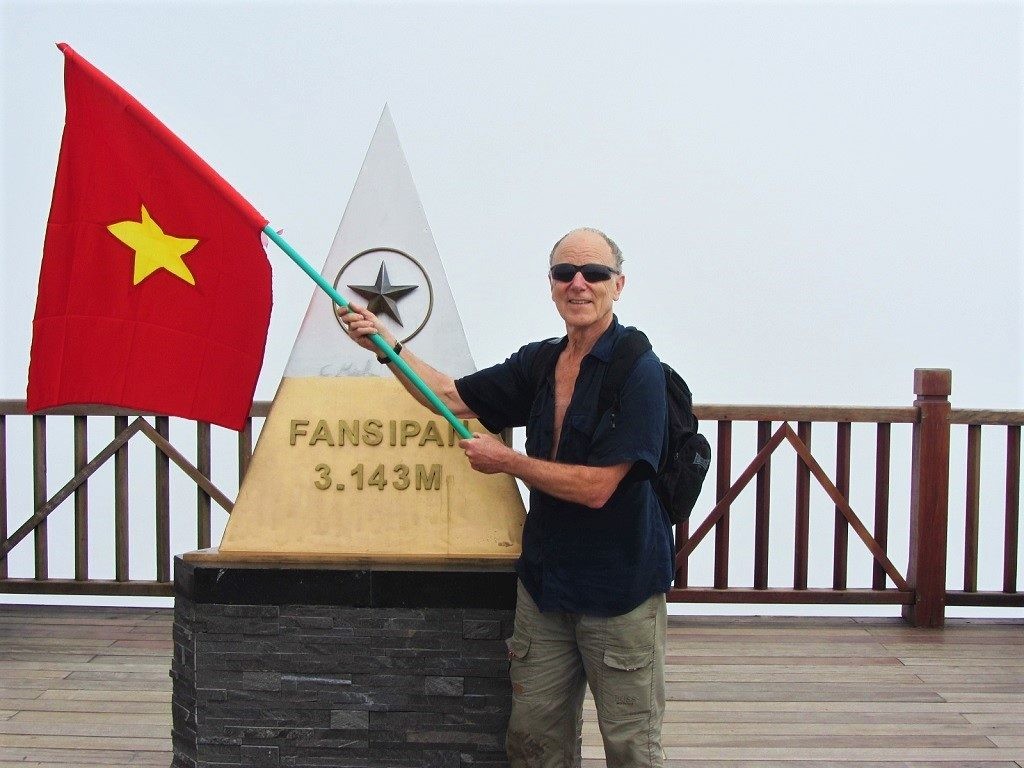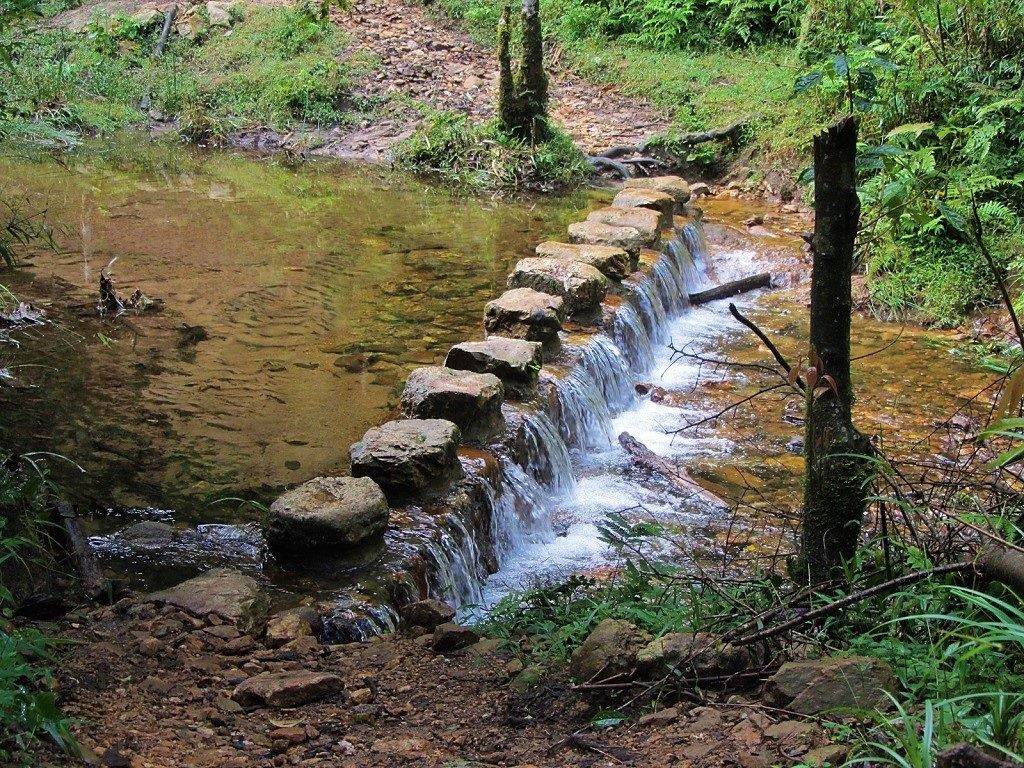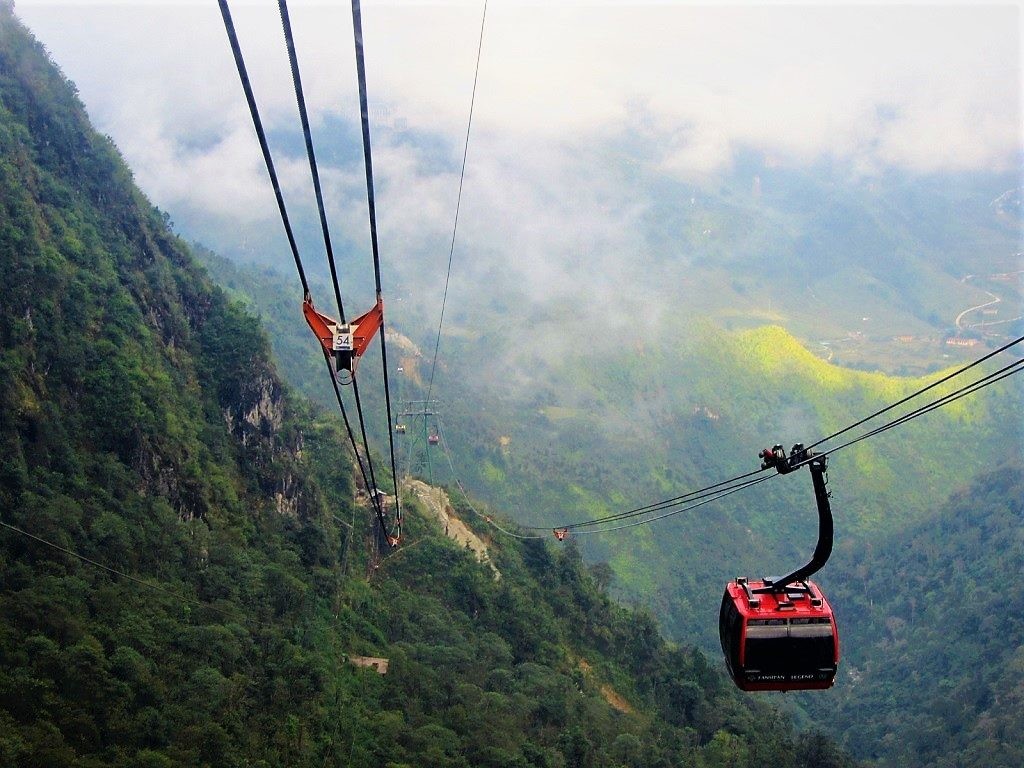Is Fansipan the highest peak in Indochina, and what is its elevation? SIXT.VN answers these questions and more, providing you with the ultimate guide to conquering this majestic mountain and experiencing the best of Vietnam travel. Let SIXT.VN be your trusted partner for unforgettable travel adventures in Vietnam, offering comprehensive services including airport transfers, hotel bookings, and exciting tours. Discover the magic of Sapa and the Hoang Lien Son range with expert travel advice.
1. What Makes Fansipan Famous?
Fansipan, also known as Phan Xi Păng, is renowned for being the highest mountain in Indochina. Standing tall at 3,143 meters (10,312 feet), it presents a challenging yet rewarding trek for adventure enthusiasts. Its fame is also attributed to the breathtaking panoramic views from the summit, showcasing the stunning landscapes of the Hoang Lien Son mountain range.
1.1 What is the Significance of Fansipan’s Height?
Fansipan’s impressive height makes it a prominent landmark in Southeast Asia. Conquering this peak is a significant achievement for hikers and climbers, offering a sense of accomplishment and unparalleled views. According to research from the Vietnam National Administration of Tourism in 2023, Fansipan attracts a large number of tourists annually, contributing significantly to the tourism sector in Sapa.
1.2 What Can You See at the Top of Fansipan?
At the summit of Fansipan, you can witness a breathtaking panorama of rolling mountains, lush valleys, and cloud formations. The experience is particularly magical during sunrise and sunset when the landscapes are bathed in golden light. Additionally, the summit features a complex of temples and a large Buddha statue, adding a cultural dimension to your visit.
 Panoramic view from Fansipan summit, showcasing the majestic Hoang Lien Son mountain range
Panoramic view from Fansipan summit, showcasing the majestic Hoang Lien Son mountain range
2. Is Fansipan the Highest Mountain in Indochina?
Yes, Fansipan proudly holds the title of the highest peak in Indochina. Its elevation of 3,143 meters (10,312 feet) surpasses all other mountains in Vietnam, Laos, and Cambodia, making it a coveted destination for mountaineers and nature lovers.
2.1 How Does Fansipan Compare to Other Peaks in Southeast Asia?
While Fansipan is the highest in Indochina, other peaks in Southeast Asia rival its grandeur. Mount Kinabalu in Malaysia, for instance, stands at 4,095 meters. However, Fansipan remains the ultimate challenge for those exploring Vietnam, Laos, and Cambodia.
2.2 What Makes Climbing Fansipan a Unique Experience?
Climbing Fansipan offers a unique blend of natural beauty and cultural immersion. The trek takes you through diverse terrains, from lush forests to rocky cliffs, and introduces you to the local culture of the ethnic communities residing in the Sapa region. Plus, the option to descend via cable car provides a modern twist to this classic adventure.
3. How High Is Fansipan Mountain?
Fansipan stands at an impressive height of 3,143 meters (10,312 feet). This altitude not only defines its significance as the “Roof of Indochina” but also presents unique challenges and rewards for climbers.
3.1 How Does the Altitude Affect the Climbing Experience?
The high altitude of Fansipan significantly impacts the climbing experience. As you ascend, the air becomes thinner, leading to breathing difficulties and potential altitude sickness. Climbers need to acclimatize properly and maintain a steady pace to avoid exhaustion and ensure a safe ascent.
3.2 What is the Best Time to Climb Fansipan?
The ideal times to climb Fansipan are during spring (March to April) and autumn (September to October). These months offer the most favorable weather conditions with clear skies and mild temperatures. Avoiding the rainy season ensures a safer and more enjoyable trek.
4. Planning Your Trip to Fansipan: A Comprehensive Guide
Planning a trip to Fansipan requires careful consideration of various factors, including fitness level, supplies, and safety precautions. Whether you prefer trekking independently or opting for a guided tour, preparation is key to a successful and memorable experience.
4.1 How Fit Do You Need to Be to Climb Fansipan?
Climbing Fansipan via the Tram Ton Pass trail requires a reasonable level of fitness. The trek is strenuous, involving steep ascents and rocky terrains. Regular exercise and stamina training are recommended to prepare your body for the physical demands of the climb.
4.2 What Supplies and Equipment Are Essential for the Climb?
Essential supplies and equipment for climbing Fansipan include:
- Hiking Shoes: Sturdy and comfortable hiking shoes with good traction.
- Appropriate Clothing: Layers of warm, windproof, and waterproof clothing.
- Backpack: A small backpack to carry essentials.
- Water: At least three liters of water to stay hydrated.
- Food: Energy bars, snacks, and light meals.
- First Aid Kit: Basic medical supplies for minor injuries.
- Flashlight: A small flashlight for emergencies.
- Mobile Phone: With a local SIM card and fully charged.
 Climbers on Fansipan, equipped with hiking gear and backpacks
Climbers on Fansipan, equipped with hiking gear and backpacks
4.3 Is it Safe to Climb Fansipan Without a Guide?
While it’s possible to climb Fansipan without a guide, it’s crucial to prioritize safety. Independent climbers should be well-prepared, follow marked trails, and monitor weather conditions. Consider hiring a guide for added safety and local expertise, especially if you are a novice climber.
4.4 What Are the Different Routes to Climb Fansipan?
There are three main trails to reach the summit of Fansipan:
- Tram Ton Pass Trail: The most popular and easiest route, suitable for independent climbers.
- Sin Chai Trail: A more challenging route through remote villages.
- Cat Cat Trail: A scenic but strenuous trail passing through Cat Cat village.
4.5 How Can SIXT.VN Help You Plan Your Fansipan Adventure?
SIXT.VN offers comprehensive travel services to help you plan your Fansipan adventure, including:
- Transportation: Airport transfers and transportation to the trailhead.
- Accommodation: Hotel bookings in Sapa.
- Tours: Guided trekking tours to Fansipan.
- Travel Advice: Expert tips and recommendations for a safe and enjoyable trip.
5. Climbing Fansipan: A Step-by-Step Guide
Climbing Fansipan is an adventure that rewards you with stunning views and a sense of accomplishment. This step-by-step guide provides you with essential information to navigate the trek successfully.
5.1 Getting to the Trailhead
The most common starting point for climbing Fansipan is the Tram Ton Pass trailhead, located near Love Waterfall, about 15 kilometers west of Sapa. You can reach the trailhead by taxi or motorbike from Sapa.
5.2 The Ascent: What to Expect Along the Way
The ascent via the Tram Ton Pass trail is approximately 11.2 kilometers and takes about 6-9 hours, depending on your pace and fitness level. The trail starts gently through forests and gradually becomes steeper and rockier as you ascend.
5.3 Key Milestones and Landmarks on the Trail
- Love Waterfall: The starting point of the Tram Ton Pass trail.
- First Campsite (2,200m): A resting point with basic facilities.
- Second Campsite (2,800m): Another resting point before the final ascent.
- Dwarf Bamboo Forest: A unique ecosystem with short bamboo trees.
- Summit: The ultimate destination with panoramic views and cultural landmarks.
5.4 Safety Tips for the Climb
- Stay Hydrated: Drink plenty of water throughout the climb.
- Pace Yourself: Maintain a steady pace to avoid exhaustion.
- Follow Marked Trails: Stick to the designated paths to avoid getting lost.
- Check Weather Conditions: Be aware of changing weather and adjust your plans accordingly.
- Inform Someone: Let someone know your hiking plans and expected return time.
 Hiking trail up Fansipan, showcasing the natural beauty of the mountain
Hiking trail up Fansipan, showcasing the natural beauty of the mountain
5.5 Reaching the Summit: What Awaits You
Upon reaching the summit, you’ll be greeted with:
- Panoramic Views: Stunning views of the Hoang Lien Son mountain range.
- Cultural Landmarks: Temples, a large Buddha statue, and other religious structures.
- Tourist Facilities: Restaurants, souvenir shops, and photography booths.
6. Modern Conveniences: The Fansipan Cable Car
The Fansipan cable car offers a convenient alternative to trekking, allowing visitors to reach the summit in just 15 minutes. While some purists may prefer the challenge of the climb, the cable car provides an accessible option for those with limited time or physical constraints.
6.1 How Does the Cable Car Change the Fansipan Experience?
The cable car has transformed the Fansipan experience by making the summit accessible to a broader audience. It allows people of all ages and fitness levels to enjoy the stunning views and cultural landmarks at the top.
6.2 What is the Cost of the Cable Car?
The cost of the Fansipan cable car is approximately 700,000 VND ($30) one way for adults. While this may seem expensive, it provides a convenient and time-saving alternative to the strenuous trek.
6.3 What Are the Benefits of Taking the Cable Car?
- Time-Saving: Reaches the summit in just 15 minutes.
- Accessibility: Suitable for all ages and fitness levels.
- Comfort: Provides a smooth and comfortable ride.
- Scenic Views: Offers stunning views of the surrounding landscapes.
 Fansipan cable car, providing a convenient and scenic ride to the summit
Fansipan cable car, providing a convenient and scenic ride to the summit
6.4 The Descent: Cable Car vs. Trekking Down
After reaching the summit, you have the option to descend via cable car or trek back down. The cable car is a faster and easier option, while trekking down offers a more immersive experience of the mountain’s natural beauty.
7. Exploring Sapa: Beyond Fansipan
Sapa is a captivating destination that offers more than just the challenge of Fansipan. The region is rich in cultural diversity, stunning landscapes, and unique experiences that are worth exploring.
7.1 What Other Attractions Does Sapa Offer?
- Cat Cat Village: A traditional Hmong village with cultural performances and handicrafts.
- Muong Hoa Valley: Home to ancient stone carvings and picturesque rice terraces.
- Sapa Market: A vibrant local market with traditional clothing, souvenirs, and local produce.
- Ham Rong Mountain: A botanical garden with panoramic views of Sapa town.
- Ta Phin Village: Known for its Red Dao culture and traditional herbal baths.
7.2 How Can You Immerse Yourself in the Local Culture?
To immerse yourself in the local culture, you can:
- Visit Local Villages: Interact with ethnic communities and learn about their traditions.
- Attend Cultural Performances: Experience traditional music, dance, and storytelling.
- Try Local Cuisine: Sample authentic Vietnamese dishes and regional specialties.
- Stay in a Homestay: Experience daily life with a local family.
- Shop at Local Markets: Purchase handmade crafts and support local artisans.
 Rice terraces in Muong Hoa Valley, showcasing the stunning landscapes of Sapa
Rice terraces in Muong Hoa Valley, showcasing the stunning landscapes of Sapa
7.3 What Activities Can You Enjoy in Sapa?
- Trekking: Explore the stunning landscapes and remote villages.
- Mountain Biking: Discover the region on two wheels.
- Photography: Capture the breathtaking scenery and cultural moments.
- Cultural Tours: Learn about the local culture and traditions.
- Relaxation: Enjoy herbal baths and spa treatments.
7.4 Where to Stay in Sapa: SIXT.VN Recommendations
SIXT.VN recommends the following accommodations in Sapa:
- Topas Ecolodge: An eco-friendly resort with stunning views.
- Hotel de la Coupole – MGallery: A luxurious hotel with French colonial architecture.
- Sapa Clay House – Mountain Retreat: A charming retreat with unique clay houses.
- Cat Cat Garden Hotel: A cozy hotel near Cat Cat village.
- Sunny Mountain Hotel: A centrally located hotel with comfortable rooms.
8. Essential Travel Tips for Visiting Fansipan and Sapa
Visiting Fansipan and Sapa requires some preparation to ensure a smooth and enjoyable trip. Here are some essential travel tips to keep in mind.
8.1 What to Pack for Your Trip
- Clothing: Layers of warm, waterproof, and windproof clothing.
- Footwear: Sturdy hiking shoes or boots.
- Accessories: Hat, gloves, scarf, and sunglasses.
- Personal Items: Sunscreen, insect repellent, and toiletries.
- Electronics: Camera, mobile phone, and charger.
8.2 How to Get Around Sapa
- Taxi: Readily available for short distances.
- Motorbike: A popular option for exploring the region independently.
- Walking: Ideal for exploring Sapa town and nearby villages.
- Trekking: The best way to discover the remote landscapes.
8.3 Local Customs and Etiquette
- Respect Local Culture: Dress modestly and be mindful of local traditions.
- Ask Permission Before Taking Photos: Especially when photographing people.
- Bargain Respectfully: When shopping at local markets.
- Learn Basic Vietnamese Phrases: To enhance your interactions with locals.
- Support Local Businesses: By purchasing handicrafts and dining at local restaurants.
8.4 Health and Safety Precautions
- Consult Your Doctor: About necessary vaccinations and health precautions.
- Drink Bottled Water: To avoid waterborne illnesses.
- Use Insect Repellent: To protect against mosquito bites.
- Be Aware of Altitude Sickness: If climbing Fansipan.
- Travel Insurance: Ensure you have comprehensive travel insurance.
9. Why Choose SIXT.VN for Your Vietnam Travel Needs?
SIXT.VN is your trusted partner for unforgettable travel adventures in Vietnam. With our comprehensive services and expert travel advice, we ensure a seamless and enjoyable experience from start to finish.
9.1 What Services Does SIXT.VN Offer?
- Airport Transfers: Safe and convenient airport pickup and drop-off services.
- Hotel Bookings: A wide selection of accommodations to suit your budget and preferences.
- Tours: Guided tours to popular destinations, including Fansipan and Sapa.
- Car Rentals: Flexible car rental options for independent exploration.
- Travel Advice: Expert tips and recommendations for a safe and enjoyable trip.
9.2 How Does SIXT.VN Ensure a Seamless Travel Experience?
- Reliable Transportation: Punctual and comfortable transportation services.
- Quality Accommodation: Handpicked hotels and resorts that meet our high standards.
- Expert Guides: Knowledgeable and experienced tour guides.
- Personalized Service: Tailored travel plans to suit your individual needs and preferences.
- 24/7 Support: Round-the-clock customer support for any assistance you may need.
9.3 The Benefits of Booking with SIXT.VN
- Convenience: Streamlined booking process and hassle-free travel arrangements.
- Reliability: Trustworthy services and dependable support.
- Value: Competitive prices and exclusive deals.
- Expertise: In-depth knowledge of Vietnam travel.
- Peace of Mind: Knowing that your travel plans are in good hands.
10. Frequently Asked Questions (FAQs) About Fansipan
10.1 Can you climb Fansipan in one day?
Yes, it is possible to climb Fansipan in one day via the Tram Ton Pass trail if you are in reasonably good physical condition.
10.2 How long does it take to climb Fansipan?
The ascent typically takes 6-9 hours, depending on your pace and fitness level.
10.3 What is the best time to visit Fansipan?
The best times to visit Fansipan are during spring (March-April) and autumn (September-October).
10.4 How much does it cost to climb Fansipan?
The cost varies depending on whether you hire a guide and take the cable car. Budget approximately $100-$200 for a guided tour and cable car ticket.
10.5 Is it necessary to hire a guide to climb Fansipan?
While it is possible to climb independently, hiring a guide is recommended for safety and local expertise.
10.6 What should I wear to climb Fansipan?
Wear layers of warm, waterproof, and windproof clothing, along with sturdy hiking shoes.
10.7 Are there any accommodations on Fansipan?
There are two basic campsites along the Tram Ton Pass trail, but most climbers stay in Sapa and make a day trip to Fansipan.
10.8 Is there a cable car to the top of Fansipan?
Yes, a cable car operates from the base to the summit of Fansipan, offering a convenient alternative to trekking.
10.9 What is there to do at the summit of Fansipan?
At the summit, you can enjoy panoramic views, visit temples and a large Buddha statue, and dine at restaurants.
10.10 How can I book a tour to Fansipan with SIXT.VN?
You can easily book a tour to Fansipan with SIXT.VN by visiting our website or contacting our customer support team.
Ready to conquer Fansipan and explore the beauty of Sapa? Let SIXT.VN be your guide! Contact us today to plan your unforgettable adventure.
Address: 260 Cau Giay, Hanoi, Vietnam
Hotline/Whatsapp: +84 986 244 358
Website: SIXT.VN



